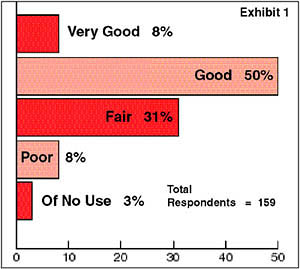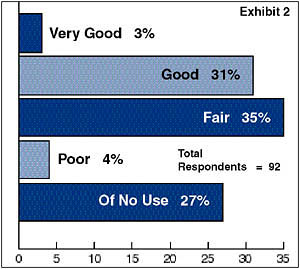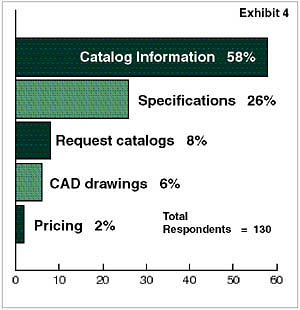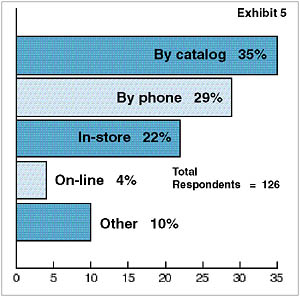

PM Engineer sent out a total of 986 surveys and received a total 227 responses, for a 23% response rate, which is quite good for a study of this nature. We were trying to find out to what extent the vaunted e-commercialization of America has impacted our audience. The responses suggest you folks are not laggards when it comes to making good use of the Internet.

Also, while the aforementioned 72% said they have visited a manufacturer's Web site, only one out of five engineers surveyed said they have "used a specification Web site not controlled by a manufacturer to obtain specifications for a project."

Reflecting the Real World
I think this juxtaposition echoes to a large degree what is happening with the dot.com world in general. Independent, third-party construction industry sites are merging or falling by the wayside. A key to their anticipated success was rapid branding, i.e., attracting so many new users to the site and its services that its web address would become something akin to a household term among industry citizens. Calendar year 1999 and the first half of 2000 saw new sites arising almost weekly that catered to construction industry procurement, project management, specifications and other functions. Yet, a question on our survey asked, "Have you subscribed to any specification Web site(s)?" (Usually these require a fee.) Only 8% of PME's survey respondents answered affirmatively.Industry manufacturers already had the brand names and recognition the "outsider" dot.coms were trying to achieve, but tended to be a bit slow in developing top-notch sites of their own. Although most have had a Web presence for years, the vast majority of PHC manufacturers' sites were little more than electronic brochures until recently. A big reason is because prior to the dawn of the new millennium, the e-wizards hired by manufacturers were all busy trying to stave off Y2K disaster. When everyone dodged that bullet, information technology staffs could turn their attention to advancing their employers' interests online.
Question 3, "How much of the manufacturer's specifications have you used for the final specifications of a project?" shows a mixed bag of responses. A total of 48% said they trusted the manufacturer's specs for at least half the specifications used on a project, while 43% said they used "Some."
Electronic catalogs are by far the most useful feature used by online specifiers. Exhibit 4 shows that 58% of PME's respondents answered "Catalog information" in response to the question, "What do you use on the manufacturer's Web site the most?" Another 26% said "Specifications," while 8% used manufacturer Web sites to "Request catalogs" and 6% for "CAD drawings." Only 2% said they used the manufacturer's Web site for "Pricing."

Why Online Buying Lags
Only 10% of respondents responded "Yes" to a query asking, "Have you purchased any plumbing-related materials online?" A related question, the results of which are shown in Exhibit 5, shows that engineers for some reason have not taken to online purchasing. Asked their "most preferred purchasing method," 35% said "By catalog," 29% "By phone," and 22% "In-store." Only 4% rated "Online" their preferred method.Our survey didn't attempt to gauge the reasons why more people aren't captivated by the alleged convenience and bargain-hunting capabilities of online purchasing. Nonetheless, I will venture an educated guess. It's because online purchasing does not yet have significant advantages over traditional methods. For one thing, selection is limited, and it is limited because all manufacturers do not perceive it in their interest to display their wares and prices in a third-party forum. It's like Yellow Pages advertising, where all providers of a given service appear in proximity to competitors. It's not the way to build a loyal, captive audience interested in something other than the lowest price.
Also, for many, online purchasing does not even live up to some of its major alleged selling points-cost and convenience. Which takes less time, logging on and navigating through one or more unfamiliar Web sites, or taking a catalog from the shelf and calling your favorite supplier? Many prices cited over the Web are not necessarily the lowest around, and even if they are, there's the issue of personal relationships built up over time. Is it worth paying 5% less for goods of uncertain origin and delivery capability?
Another survey question showed that the vast majority of our audience spends less than five hours a month checking manufacturer Web sites. A bigger surprise to me is that so many respondents admit to spending significantly more time. More than one out of five (22%) estimated they spend 5-10 hours a month visiting manufacturer Web sites, while 7% admitted to even more.

Web Sites Engineers Found Useful
One of the queries on our survey asked readers without prompting to list any manufacturers' Web sites that they regard as useful. The following sites were mentioned. Multiple responses are noted in parentheses.
A. O. Smith (5)
Allied Tube & Conduit
American Standard (5)
ARCOM Master Systems
Bell & Gossett (8)
Boiler & Valve Manufacturers
Bradford White
Carrier (3)
CMB
Conbraco
Contronics
Copper Development Association
CopperTube.com
Crane
DuctSox
Elkay (2)
Energy Kinetics
Grainger
Grinnell
Grundfos Pumps
Honeywell
Jacuzzi
Jay R. Smith (5)
Kohler (5)
Liebert
Little Giant Pump Co.
Love Control
McDonnell & Miller
McQuay International
Metlund Systems
NIBCO
Primary Fluid System Inc.
Square D
Reliable Automatic Sprinkler Co.
Rheem (2)
Slant/Fin
Sloan Valve
State
Strong Well
Taco (5)
Toto
Trane (3)
Viking Corp.
Watts (4)
Weil-McLain
Woodford Manufacturing
Zurn (3)